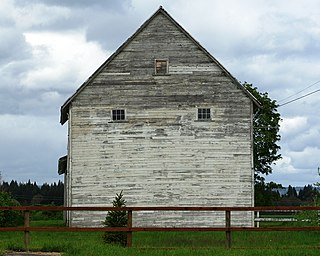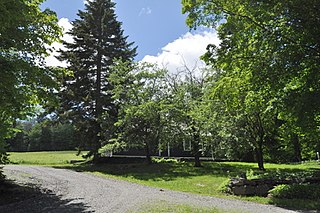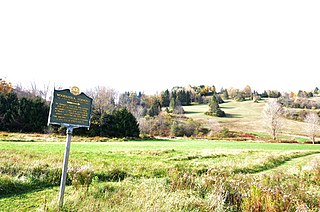
The Spencer–Peirce–Little Farm is a Colonial American farm located at 5 Little's Lane, Newbury, Massachusetts, United States, in the midst of 231 acres (93 ha) of open land bordering the Merrimack River and Plum Island Sound. The farmhouse, dating to c. 1690, was designated a National Historic Landmark in 1968 as an extremely rare 17th-century stone house in New England. It is now a nonprofit museum owned and operated by Historic New England and open to the public several days a week during the warmer months; an admission fee is charged for non Members.

Varina is a former unincorporated community and current magisterial district in the easternmost portion of Henrico County, Virginia, United States.

Blackacre State Nature Preserve is a 271-acre (110 ha) nature preserve and historic homestead in Louisville, Kentucky. The preserve features rolling fields, streams, forests, and a homestead dating back to the 18th century. For visitors, the preserve features several farm animals including horses, goats, and cows, hiking trails, and a visitor's center in the 1844-built Presley Tyler home. Since 1981, it has been used by the Jefferson County Public Schools as the site of a continuing environmental education program. About 10,000 students visit the outdoor classroom each year.

The Taylor–Bray Farm is a farm in Yarmouth Port, Massachusetts, and was originally owned and settled by Richard "of the Rock" Taylor in 1639 while it was still part of Plymouth colony. Stephen Hopkins (settler), a distant maternal line ancestor, was given permission to build a house and cut hay near this farm in 1638, but the first house in Yarmouth built by an Englishman was built by his son Giles in 1638.

Cogswell's Grant is a working farm and historic house museum in Essex, Massachusetts. It was the summer home of Bertram K. and Nina Fletcher Little, preeminent collectors of American decorative arts in the mid 20th century. Through her research and innumerable publications, Mrs. Little charted new areas of American folk art, such as decorative painting, floor coverings, boxes, and New England pottery.

Paulsdale is a historic estate and house museum in Mount Laurel Township, New Jersey. Built about 1840, it was the birthplace and childhood home of Alice Paul (1885-1977), a major leader in the Women's suffrage movement in the United States, whose activism led to passage of the Nineteenth Amendment to the United States Constitution, granting women the right to vote. It was added to the National Register of Historic Places on July 5, 1989, for its significance in social history and politics/government. Paulsdale was designated a National Historic Landmark in 1991.

The Manning–Kamna Farm is a private farm adjacent to Hillsboro in Washington County, Oregon, United States. Settled in the 1850s, ten buildings built between 1883 and 1930 still stand, including the cross-wing western farmhouse. These ten structures comprise the buildings added to the National Register of Historic Places in 2007 as an example of a farm in the region from the turn of the 20th century. Until the 1950s the farm was used to grow seeds, including rye grass and vetch. Listed buildings on the property include a barn, smokehouse, pumphouse, woodshed, and privy.

The Hanka Homestead now known as the Hanka Homestead Finnish Museum is a group of eight buildings on a 40-acre (16 ha) homestead. It is located three miles (4.8 km) west of U.S. Highway 41, off Tower Road, near Pelkie, Michigan, in the United States. The homestead was added to the National Register of Historic Places in 1984.

Greenmead Historical Park, also known as Greenmead Farms, is a 3.2-acre (1.3 ha) historic park located at 38125 Base Line Rd., Livonia, Michigan. It includes the 1841 Greek Revival Simmons House, six other structures contributing to the historic nature of the property, and additional buildings moved from other locations. Greenmead Farms was designated a Michigan State Historic Site in 1971 and listed on the National Register of Historic Places in 1972.

The McClelland Homestead is a historic farm in western Lawrence County, Pennsylvania, United States. Located along McClelland Road northeast of Bessemer, the farm complex includes buildings constructed in the middle of the 19th century. It has been designated a historic site because of its well-preserved architecture.

The Squire Cheyney Farm is an historic, American farm and national historic district that is located in Thornbury Township, Chester County, Pennsylvania.

The Lawrence Farm is a historic farm at 9 Lawrence Road in Troy, New Hampshire. Established in the early 19th century, the property has been in continuous ownership by the same family since then. Its farmstead, including a c. 1806 farmhouse, exemplifies the changing trends in domestic agricultural practices of the 19th and 20th centuries. The farm was listed on the National Register of Historic Places in 2000.

The Moore Farm and Twitchell Mill Site is a historic property on Page Road in Dublin, New Hampshire. The 6.8-acre (2.8 ha) property includes an early 19th-century farmhouse, as well as the remnants of one of Dublin's earliest industrial sites. It lies just south of a bend in Page Road in southern Dublin, where Stanley Brook runs east-west along the south side of the road. In c. 1768 Samuel Twitchell, Dublin's second settler, built a sawmill that used Stanley Brook as its power source. This mill was the second established in what is now Dublin, after that of Eli Morse. It was used until the mid-19th century, and now only its foundations remain. The farmhouse of Samuel Moore was built in a glen on the south side of the brook c. 1812, and was a vernacular Cape style farmhouse. The farm was purchased in 1935 by William and Katherine Mitchell Jackson, and the house was moved about 100 yards (91 m) to the top of a rise where it has commanding views of Mount Monadnock. The house was restored and enlarged under the guidance of architects Bradley & Church and again renovated in 1951. The farm complex includes a barn that is contemporaneous to the house, and a caretaker's cottage that is a 1952 reconstruction of an earlier one destroyed by fire.

The Crows Nest is a historic farmstead property at 35 Sturgis Drive in Wilmington, Vermont. The 75-acre (30 ha) property includes rolling woods and a hay meadow, and a small cluster of farm outbuildings near the main house, a c. 1803 Cape style building. The property typifies early Vermont farmsteads, and is now protected by a preservation easement. It was listed on the National Register of Historic Places in 1998.

The Hager Farm is a historic farmstead on United States Route 7 in southern Wallingford, Vermont. Its farmhouse, built about 1800, is one of the oldest in the community, and is regionally unusual because of its gambrel roof. The property was listed on the National Register of Historic Places in 1986.

Lee Farm is a historic farm property on Vermont Route 18 in Waterford, Vermont. Established in 1801, it was for many years worked by members of the Lee family, and part of a thriving rural community called Waterford Hollow. Its farmstead features surviving 19th and early 20th-century outbuildings and a high-quality Greek Revival farmhouse. A 5-acre (2.0 ha) portion of the farm, encompassing the farmstead, was listed on the National Register of Historic Places in 1983.

Gilbert's Hill, also known more recently as the Appel Farm, is a historic farm property and former ski area at 1362 Barnard Road in Woodstock, Vermont. Developed as a farm in the mid 19th century, it was developed as a downhill ski area in the early 20th century, and is the location of the first rope tow in the northeastern United States. It was listed on the National Register of Historic Places in 2019. The property is privately owned, but is open to the public via conservation and historic preservation easements.

The Case-Dvoor Farmstead is located on a 40-acre (16 ha) farm at 111 Mine Street in Raritan Township, near Flemington, of Hunterdon County, New Jersey. It was added to the National Register of Historic Places on December 11, 2009, for its significance in agriculture and architecture. It is now the headquarters of the Hunterdon Land Trust.
The Luce Farm is a historic farm property at 170 Luce Drive in Stockbridge, Vermont. The farm was established in the late 18th century, and is a well-preserved example of a rural agriculturally diversified farm property. It was listed on the National Register of Historic Places in 2021.

















